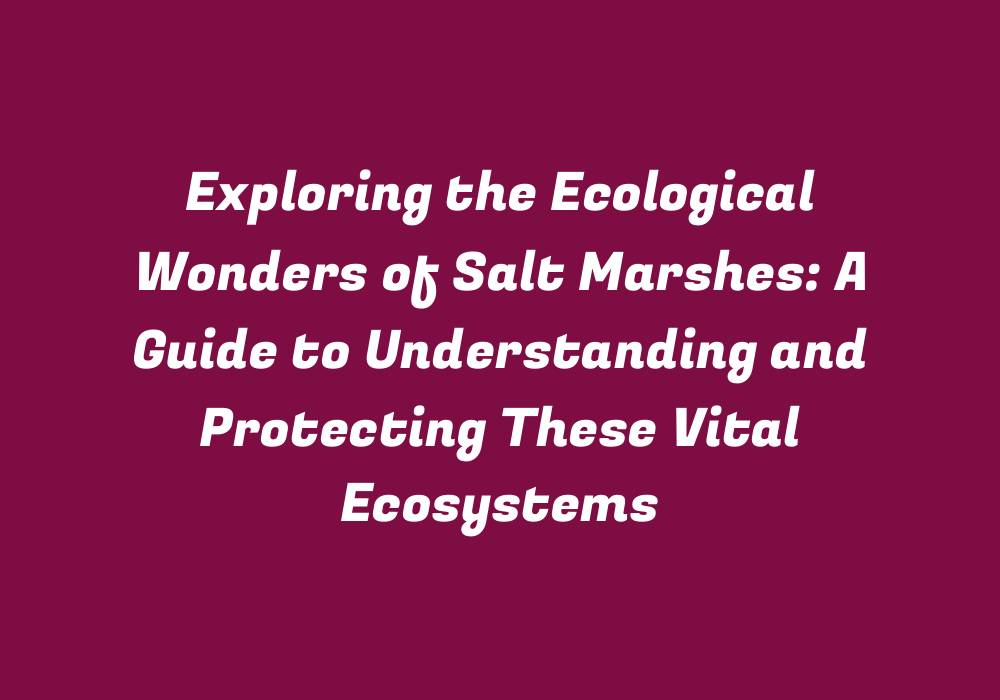Introduction to Salt Marshes: A Unique Ecological Wonder
Salt marshes are fascinating and diverse ecosystems found along the coastlines of many continents. They provide numerous benefits for both humans and wildlife, acting as a natural barrier against coastal flooding while also serving as nursery grounds for various marine species. In this article, we will explore the unique features and importance of salt marshes and offer guidance on how we can protect these vital habitats.
What are Salt Marshes?
Salt marshes are wetlands that develop at the interface between land and sea in coastal areas. They often occur in estuarine systems, such as lagoons, bays, or sheltered harbors. The vegetation in salt marshes is highly adapted to cope with fluctuating salinity levels, tidal inundation, and other environmental factors. These wetlands can be further divided into two categories: brackish water marshes (where the water is less saline), and true salt marsh regions (with higher salinity levels).
The Unique Flora of Salt Marshes
Salt marshes house a remarkable variety of plant species, many of which are adapted to survive in the harsh conditions that characterize these habitats. For example, the iconic cordgrass (Spartina alterniflora) is widely distributed along the Atlantic and Gulf coasts of North America. Cordgrass can thrive even when submerged by saltwater, thanks to its unique ability to absorb oxygen from both water and air. Other common salt marsh plants include black needlerush (Juncus roemerianus), which has a high tolerance for salinity and can withstand tidal inundation, and glassworts (Salicornia species), known for their succulent stems that store moisture even under adverse conditions.
Salt Marshes as a Haven for Wildlife
Salt marshes serve as critical habitats for many aquatic and terrestrial creatures, making them important nurseries for various marine species. These wetlands provide shelter and protection from predators while also offering rich food sources for organisms ranging from blue crabs and fiddler crabs to migratory birds. In addition, the marshes’ roots and sediments provide nutrients and help purify the surrounding water, supporting a diverse array of fish and invertebrate species.
Protecting Salt Marshes: Why it Matters
Salt marshes play an essential role in maintaining healthy coastal ecosystems, which are vital for sustaining life on Earth. They provide numerous benefits, including protecting shorelines from erosion and storm surges by buffering waves and reducing flood risks during extreme weather events. Additionally, salt marshes help filter pollutants from the water, thus ensuring cleaner marine habitats. Protecting these ecologically important areas is critical for preserving biodiversity and maintaining the overall health of coastal ecosystems.
Conservation Efforts for Salt Marshes
Several initiatives have been undertaken globally to protect and conserve salt marshes. Governments, non-governmental organizations, and private entities are working together in an effort to promote sustainable practices that minimize human impacts on these vital habitats. Some of the key strategies include:
- Restoration projects: The restoration of damaged or degraded salt marshes can help revive their ecological functions and ensure better wildlife habitats.
- Education and awareness campaigns: Promoting an understanding of the importance of salt marshes among local communities, stakeholders, and policymakers is crucial for shaping decisions that prioritize their protection.
- Regulatory measures: Strict regulations can help protect these vital habitats by limiting human activities that may negatively impact them. For example, implementing zoning laws to prohibit development in sensitive coastal areas can help safeguard salt marshes from potential threats such as pollution and habitat loss.
- Monitoring and research: Continuous monitoring of environmental conditions and conducting scientific studies will enhance our understanding of these unique ecosystems. This knowledge, in turn, can inform future conservation actions and policies.
Conclusion
Salt marshes are vital components of our planet’s delicate coastal ecosystems. These wetlands play a crucial role in maintaining biodiversity, protecting shorelines from erosion and flooding, and supporting the livelihood of numerous species. By raising awareness about the importance of salt marshes and working together to protect these precious habitats, we can ensure their continued existence for generations to come.
